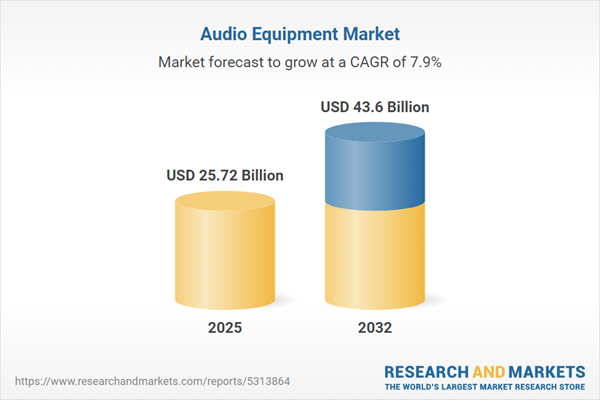Speak directly to the analyst to clarify any post sales queries you may have.
The global audio equipment market is entering a pivotal phase, shaped by innovative technology, shifting consumer preferences, and evolving business models. Senior executives must adjust strategies to capitalize on new growth drivers and navigate regulatory and operational challenges.
Market Snapshot: Audio Equipment Market Size and Growth
The Audio Equipment Market grew from USD 23.80 billion in 2024 to USD 25.72 billion in 2025. It is expected to continue expanding at a CAGR of 7.85%, reaching USD 43.60 billion by 2032. This robust trajectory is fueled by rising demand for high-fidelity sound across both residential and professional applications, as well as ongoing advancements in audio technologies and integration with digital ecosystems.
Scope & Segmentation of the Audio Equipment Market
This report provides an in-depth analysis of the audio equipment sector, mapped across the following core segments and geographic regions, ensuring comprehensive market coverage:
- Product Types: Amplifiers, Headphones (In Ear, Noise Cancelling, Over Ear, True Wireless, Dual Ear Buds, Uni Ear Buds), Microphones, Mixers, Speakers (Home Theater, Portable, Smart Speakers, Soundbars)
- Distribution Channels: Direct Sales, Electronics Retail (Big Box Retailers, Consumer Electronics Chains), Online Retail (E-Commerce Marketplaces, Manufacturer Website), Specialty Retail (Music Instrument Stores, Pro Audio Stores)
- End Users: Consumer, Enterprise (Corporate, Education, Hospitality), Professional (Broadcasters, Music Studios, Podcasters)
- Technologies: Wired (Analog: RCA, Three Point Five Millimeter, XLR; Digital: HDMI, Optical, USB), Wireless (Bluetooth: BLE, Classic; RF; Wi-Fi)
- Price Ranges: Budget Tier, Mid Tier, Premium Tier, Luxury Tier
- Regions: Americas (North America: United States, Canada, Mexico; Latin America: Brazil, Argentina, Chile, Colombia, Peru), Europe, Middle East & Africa (Europe: United Kingdom, Germany, France, Russia, Italy, Spain, Netherlands, Sweden, Poland, Switzerland; Middle East: United Arab Emirates, Saudi Arabia, Qatar, Turkey, Israel; Africa: South Africa, Nigeria, Egypt, Kenya), Asia-Pacific (China, India, Japan, Australia, South Korea, Indonesia, Thailand, Malaysia, Singapore, Taiwan)
- Key Companies: Sony Corporation, Samsung Electronics Co., Ltd., Apple Inc., Bose Corporation, Panasonic Corporation, LG Electronics Inc., Harman International Industries, Inc., Sennheiser electronic GmbH & Co. KG, Shure Incorporated, Logitech International S.A.
Key Takeaways for Senior Decision-Makers
- Collaborative partnerships between device manufacturers, digital content providers, and telecom firms are essential for building integrated solutions and scaling ecosystem reach.
- Consumer adoption extends beyond traditional audiophiles: mobile streaming, content creation, and smart home integration are driving mass-market demand for versatile and design-focused devices.
- Enterprises and professional segments demand precision equipment, with modular solutions gaining appeal for their adaptability to varied workflows.
- Sustainability is a rising priority, driving investments in recyclable materials and low-energy manufacturing, particularly in regions with stringent regulations.
- Software-driven platforms and subscription-based services complement hardware revenue and create opportunities for recurring engagement and differentiation.
Tariff Impact on Audio Equipment Supply Chain
Recent United States tariffs have increased landed costs for imported components, prompting suppliers to rethink sourcing and consider nearshore production. Retailers face tighter margins and are adjusting product portfolios, while premium categories have seen proportionately greater price escalations. Budget-focused market segments have absorbed cost pressures through design changes, sometimes impacting quality perceptions. Ongoing analysis of tariff schedules and proactive supplier management is crucial to maintain profitability and customer loyalty.
Methodology & Data Sources
This report combines primary research—via executive interviews, distribution partner discussions, professional user feedback, and focus group input—with secondary research that reviews industry reports, regulatory filings, regional trade publications, and academic sources. Quantitative data is validated using publicly disclosed company data, macroeconomic indicators, and cross-referenced proprietary shipment figures. Peer review checkpoints enhance data accuracy and reliability.
Why This Report Matters
- Enables senior leaders to pinpoint and act on fast-emerging opportunities and disruptive threats as technology and business models converge across segments and regions.
- Provides deep, actionable insights to guide investment, supply chain, and channel strategies tailored to each target demographic and geographic region.
Conclusion
The audio equipment industry is transforming through technological innovation, new business models, and rapid changes in consumer and professional demand. Informed, agile strategies and continuous market intelligence are essential for sustained leadership and future-ready growth.
Additional Product Information:
- Purchase of this report includes 1 year online access with quarterly updates.
- This report can be updated on request. Please contact our Customer Experience team using the Ask a Question widget on our website.
Table of Contents
3. Executive Summary
4. Market Overview
7. Cumulative Impact of Artificial Intelligence 2025
Companies Mentioned
The companies profiled in this Audio Equipment market report include:- Sony Corporation
- Samsung Electronics Co., Ltd.
- Apple Inc.
- Bose Corporation
- Panasonic Corporation
- LG Electronics Inc.
- Harman International Industries, Inc.
- Sennheiser electronic GmbH & Co. KG
- Shure Incorporated
- Logitech International S.A.
Table Information
| Report Attribute | Details |
|---|---|
| No. of Pages | 193 |
| Published | October 2025 |
| Forecast Period | 2025 - 2032 |
| Estimated Market Value ( USD | $ 25.72 Billion |
| Forecasted Market Value ( USD | $ 43.6 Billion |
| Compound Annual Growth Rate | 7.8% |
| Regions Covered | Global |
| No. of Companies Mentioned | 11 |









